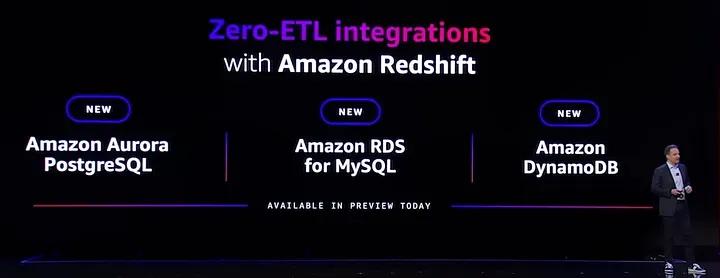
AWS Re: Invent 2023 — Major Announcements
Welcome to a journey into the heart of cloud innovation! AWS Re: Invent 2023 was not just a conference; it was an immersive experience, and I had the privilege of attending all the keynotes in person. As a first-timer, the sheer magnitude of insights, announcements, and groundbreaking technologies left an indelible mark on my cloud journey.
Published Jan 28, 2024

The second day of AWS re: Invent 2023 kicked off with a keynote from the CEO of Amazon Web Services, Adam Selipsky. He shared his perspective on cloud transformation and provided an exclusive first look at AWS’s innovative artificial intelligence, machine learning, and infrastructure advancements.

Amazon S3 Express One Zone high-performance storage class: The new Amazon S3 Express One Zone storage class is designed to deliver up to 10x better performance than the S3 Standard storage class and is a great fit for your most frequently accessed data and your most demanding applications.

Memory-optimized, AWS Graviton4-powered Amazon EC2 instances (R8g) (Preview): Equipped with brand-new Graviton4 processors, the new R8g instances will deliver better price performance than any existing memory-optimized instance.

Trainium 2 AI chip: A new AI chip that can train foundational models twice as fast. The second-generation Trainium 2 boasts a remarkable fourfold increase in model training speed compared to its predecessor. Trainium 2 features three times its predecessor's memory capacity, allowing it to handle more complex and larger datasets.

Agents for AWS Bedrock: fully managed Agents for Amazon Bedrock enable generative AI applications to execute multistep tasks using company systems and data sources. Agents can plan and perform most business tasks, such as answering questions about product availability or taking orders.

- Customize models in Amazon Bedrock with your data using fine-tuning and continued pre-trainingPrivately and securely customize foundation models with your data in Amazon Bedrock to build applications that are specific to your domain, organization, and use case.
- Knowledge Bases now delivers fully managed RAG experience in Amazon Bedrock
With a knowledge base, you can securely connect foundation models (FMs) in Amazon Bedrock to your company data for Retrieval Augmented Generation (RAG).

Guardrails for AWS Bedrock (preview): With Guardrails for Amazon Bedrock, customers can implement safeguards across models based on application requirements and responsible AI policies

Zero-ETL integration with Amazon Redshift: Adam announced four new zero-ETL integrations that automatically connect data from the source to the destination and eliminate the burden of extract, transform, and load (ETL) jobs.
- Amazon Aurora PostgreSQL zero-ETL integration with Amazon Redshift
- Amazon RDS for MySQL zero-ETL integration with Amazon Redshift
- Amazon DynamoDB zero-ETL integration with Amazon Redshift
- Amazon DynamoDB zero-ETL integration with Amazon OpenSearch Service

Amazon Q: Amazon Q provides generative AI-powered assistance across Amazon QuickSight, Amazon Connect, and AWS Supply Chain

- Amazon Q in Amazon QuickSight (preview): Amazon QuickSight is a unified BI service built for the cloud that offers interactive dashboards, paginated reports, and embedded analytics, plus natural-language querying capabilities.
- Amazon Q in Amazon Connect (generally available): Amazon Connect is the cloud contact center that enables organizations of all sizes to deliver superior customer experiences at lower costs.
- Amazon Q in AWS Supply Chain (coming soon): AWS Supply Chain is a cloud-based application that gives customers insights into their supply chain by combining Amazon’s nearly 30 years of supply chain experience with the resilience, security, and business continuity of AWS.

Amazon DataZone AI Recommendations (preview): A service that helps customers create and manage data catalogs. This feature can automate the process of data cataloging and discovery by using large language models to generate detailed descriptions of data assets and their schemas and suggest analytical use cases. This can help data producers and consumers understand the relevance and context of their data, and reduce the time and effort needed to provide insights and actions.

- New Amazon EC2 instances powered by NVIDIA GH200, H200, L40S, and L4 GPUs supercharge generative AI, HPC, design, and simulation workloads
- AWS to offer first cloud AI supercomputer with NVIDIA Grace Hopper Superchip and AWS UltraCluster scalability
- NVIDIA DGX Cloud — first to feature NVIDIA GH200 NVL32 — coming to AWS
- AWS will introduce three additional new Amazon EC2 instances: P5e ,G6, and G6e instances for a wide set of applications such as AI fine-tuning, inference, graphics, and video workloads.
The complete keynote can be found here

The third day of AWS re: Invent 2023 kicked off with a keynote from the VP of Machine Learning at Amazon Web Services, Dr. Swami Sivasubramanian. He initiated his narrative by highlighting comparable symbiotic associations in nature that draw parallels to the ongoing technological synergy involving Data, Humans, and Generative AI. Additionally, he underscores that the inclination to cultivate this relationship is not a recent development but one with historical roots. The journey traces back to the 1830s, marked by figures like Ada Lovelace, acknowledged as the inaugural computer programmer, renowned for her contributions to the Analytical Engine.
Major announcements from Dr. Swami Sivasubramanian’s keynote:

Claude 2.1 foundation model from Anthropic is now generally available in Amazon Bedrock: The newest model offers an industry-leading 200,000 token context window, reduced rates of hallucination, improved accuracy over long documents, system prompts, and a beta tool use feature for function calling and workflow orchestration.

Meta’s Llama 2 70B model: Llama 2 70B is available now on Amazon Bedrock and is suitable for large-scale tasks, such as language modeling, text generation, and dialogue systems

Amazon Titan Multimodal Embeddings: Allows organizations to build more accurate and contextually relevant multimodal search and smart recommendation experiences. The model converts images and short text into embeddings — numerical representations that allow the model to easily understand semantic meanings and relationships among data. These are stored in a customer’s vector database

Amazon Titan Text models — Express and Lite: Amazon Titan Text Express and Amazon Titan Text Lite are large language models (LLMs) that help users improve productivity and efficiency for an extensive range of text-related tasks, and offer price and performance options that are optimized for your needs.

AWS Generative AI Innovation Center’s Custom Model Program for Anthropic Claude: Users can engage with researchers and ML scientists from the Generative AI Innovation Center to fine-tune Anthropic Claude models securely with their own proprietary data.

Amazon Titan image generation in Amazon Bedrock: Now, AWS users can generate realistic, studio-quality images at large volumes and low costs using natural language prompts in Amazon Bedrock. Also, AWS’s Generative AI Innovation Center will be providing AI certifications and helping customers with their Bedrock generative AI applications.

Amazon SageMaker HyperPod: Helps reduce time-to-train foundation models (FMs) by providing a purpose-built infrastructure for distributed training at scale, helping to reduce the time it takes to train models by up to 40%.

Vector engine for Amazon OpenSearch Serverless is now available: The vector engine makes it easy for you to build modern machine learning-augmented search experiences and generative AI applications without needing to manage the underlying vector database infrastructure.

Vector search for Amazon DocumentDB (with MongoDB compatibility) is now generally available: This new built-in capability lets you store, index, and search millions of vectors with millisecond response times within your document database.
Vector search for Amazon DynamoDB: Amazon DynamoDB zero-ETL integration with Amazon OpenSearch Service enables full-text and vector search on operational data in near real-time

Amazon MemoryDB for Redis: This will support vector search, leading to faster response times and allowing tens of thousands of queries per second. It’s a useful application, in particular, for fraud detection in financial services.

Amazon Neptune analytics: An analytics database engine that can help surface insights by analyzing tens of billions of connections in seconds with built-in graph algorithms, enabling faster vector searches with both graphs and data.
Amazon Q is a secure AI chatbot for business use that can be tailored to specific organizational data. Today, Dr. Sivasubramanian announced a few additional ways it will integrate with other Amazon services.

Amazon Q generative SQL for Amazon Redshift Serverless: Enables data engineering teams to accelerate data pipeline build. Q can write SQL queries faster using natural language and help simplify the process for custom ETL jobs. (Produces SQL query recommendations from plain English)

Amazon Q data integration in AWS Glue: Amazon Q data integration in AWS Glue enables data engineers and ETL developers to build data integration jobs using natural language. Engineers and developers can ask Q to author jobs, troubleshoot issues, and answer questions about AWS Glue and data integration. (Simplify custom ETL jobs and integrate data using natural language)

Amazon OpenSearch Service zero-ETL integration with Amazon S3: Amazon OpenSearch Service zero-ETL integration with Amazon S3, a new way to query operational logs in Amazon S3 and S3-based data lakes without needing to switch between tools to analyze operational data, is available for customer preview. Users can boost the performance of their queries and build fast-loading dashboards using the built-in query acceleration capabilities of Amazon OpenSearch Service zero-ETL integration with Amazon S3.

AWS Clean Rooms ML: Helps users apply machine learning models to generate predictive insights without sharing underlying raw data. Also specifies training datasets using the AWS Glue Data Catalog.

Model Evaluation on Amazon Bedrock: Facilitates access to curated datasets and predefined metrics for automatic evaluations, helping to evaluate, compare, and select the best foundation models for AI use cases.
The complete keynote can be found here
Watch the complete keynotes of AWS Re: Invent 2023:
As we conclude this blog capturing the key highlights of AWS Re: Invent 2023, I’m left with a sense of awe at the depth of innovation showcased. The advancements in AI, machine learning, and infrastructure are not just about technology; they signify a transformative journey shaping the future of the cloud.
I’m immensely thankful to the AWS team for orchestrating an event that goes beyond being informative; it’s an experience that sparks curiosity and drives us to explore the endless possibilities in the cloud ecosystem.
As we navigate the ever-evolving landscape of cloud technology, let’s carry forward the learnings, insights, and the spirit of innovation gained from AWS Re: Invent 2023. Together, we continue to shape the future of cloud computing. Until the next Re: Invent, let’s stay inspired, stay curious, and stay connected in the cloud.
Feel free to connect on Linkedin!!
